
The Pterygota are a subclass of insects that includes the winged insects. It also includes insect orders that are secondarily wingless.
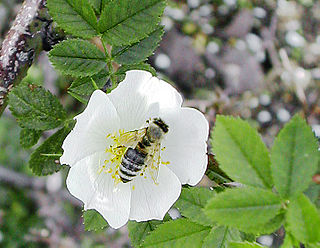
Neoptera is a classification group that includes most orders of the winged insects, specifically those that can flex their wings over their abdomens. This is in contrast with the more basal orders of winged insects, which are unable to flex their wings in this way.
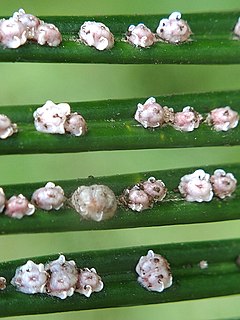
The scale insects are small insects of the order Hemiptera, suborder Sternorrhyncha. Of dramatically variable appearance and extreme sexual dimorphism, they comprise the superfamily Coccoidea. Adult females typically have soft bodies and no limbs, and are concealed underneath domed scales, extruding quantities of wax for protection. Some species are hermaphroditic, with a combined ovotestis instead of separate ovaries and testes. Males, in the species where they occur, have legs and sometimes wings, and resemble small flies. Scale insects are herbivores, piercing plant tissues with their mouthparts and remaining in one place, feeding on sap. The excess fluid they imbibe is secreted as honeydew on which sooty mold tends to grow. The insects often have a mutualistic relationship with ants, which feed on the honeydew and protect them from predators. There are about 8,000 described species.

The Exopterygota, also known as Hemipterodea, are a superorder of insects of the subclass Pterygota in the infraclass Neoptera, in which the young resemble adults but have externally developing wings. They undergo a modest change between immature and adult, without going through a pupal stage. The nymphs develop gradually into adults through a process of moulting.

Ensifera is a suborder of insects that includes the various types of crickets and their allies including: true crickets, camel crickets, bush crickets or katydids, grigs, wetas and Cooloola monsters. It and the suborder Caelifera make up the order Orthoptera. Ensifera is believed to be a more ancient group than Caelifera, with its origins in the Carboniferous period, the split having occurred at the end of the Permian period. Unlike the Caelifera, the Ensifera contain numerous members that are partially carnivorous, feeding on other insects as well as plants.

The name Apterygota is sometimes applied to a subclass of small, agile insects, distinguished from other insects by their lack of wings in the present and in their evolutionary history; notable examples are the silverfish, the firebrat, and the jumping bristletails. Their first known occurrence in the fossil record is during the Devonian period, 417–354 million years ago.
The most recent understanding of the evolution of insects is based on studies of the following branches of science: molecular biology, insect morphology, paleontology, insect taxonomy, evolution, embryology, bioinformatics and scientific computing. It is estimated that the class of insects originated on Earth about 480 million years ago, in the Ordovician, at about the same time terrestrial plants appeared. Insects evolved from a group of crustaceans. The first insects were land bound, but about 400 million years ago in the Devonian period one lineage of insects evolved flight, the first animals to do so. The oldest insect fossil has been proposed to be Rhyniognatha hirsti, estimated to be 400 million years old, but the insect identity of the fossil has been contested. Global climate conditions changed several times during the history of Earth, and along with it the diversity of insects. The Pterygotes underwent a major radiation in the Carboniferous while the Endopterygota underwent another major radiation in the Permian.
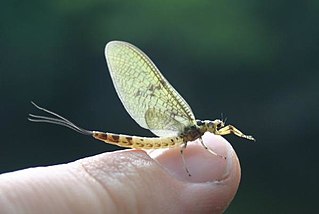
The name Palaeoptera has been traditionally applied to those ancestral groups of winged insects that lacked the ability to fold the wings back over the abdomen as characterizes the Neoptera. The Diaphanopterodea, which are palaeopteran insects, had independently and uniquely evolved a different wing-folding mechanism. Both mayflies and dragonflies lack any of the smell centers in their brain found in Neoptera.
Delitzschala is an extinct palaeodictyopteran, the oldest known to science. It was discovered by two German entomologists in 1996. Delitzschala had a wingspan of just 2½ cm (1 in) and an irregular pattern of coloured spots on its wings. Although it was 320 million years old, these spots were still visible in the fossil. It is presumed that they camouflaged the animal, since dragonflies are unable to fold their wings.
Pterygota bequaertii is a species of flowering plant in the family Malvaceae. It is found in Cameroon, Republic of Congo, Democratic Republic of the Congo, Ivory Coast, Gabon, Ghana, and Nigeria. It is threatened by exploitation as a timber tree. The wood has the trade name koto.
Pterygota macrocarpa is a species of flowering plant in the family Malvaceae. It is found in Cameroon, Ivory Coast, Ghana, Nigeria, and Sierra Leone. It is threatened by habitat loss.
Hopea pterygota is a species of plant in the family Dipterocarpaceae. It is endemic to northern Borneo.

The dustywings, Coniopterygidae, are a family of Pterygota of the net-winged insect order (Neuroptera). About 460 living species are known. These tiny insects can usually be determined to genus with a hand lens according to their wing venation, but to distinguish species, examination of the genitals by microscope is usually necessary.
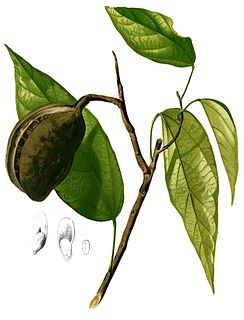
Pterygota is a genus of flowering plants in the family Malvaceae.
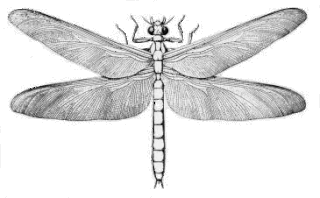
The Odonatoptera are a superorder of ancient winged insects, placed in the Palaeoptera which probably form a paraphyletic group however. The dragonflies and damselflies are the only living members of this group, which was far more diverse in the late Paleozoic and contained gigantic species, including the griffinflies of the order Protodonata. This lineage dates back at least to the Bashkirian, not quite 320 million years ago.
Sterculioideae is a subfamily of the family Malvaceae containing evergreen and deciduous trees and shrubs.
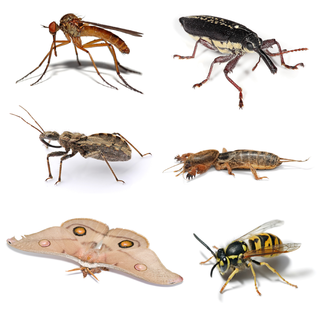
Insects or Insecta are hexapod invertebrates and the largest group within the arthropod phylum. Definitions and circumscriptions vary; usually, insects comprise a class within the Arthropoda. As used here, the term Insecta is synonymous with Ectognatha. Insects have a chitinous exoskeleton, a three-part body, three pairs of jointed legs, compound eyes and one pair of antennae. Insects are the most diverse group of animals; they include more than a million described species and represent more than half of all known living organisms. The total number of extant species is estimated at between six and ten million; potentially over 90% of the animal life forms on Earth are insects. Insects may be found in nearly all environments, although only a small number of species reside in the oceans, which are dominated by another arthropod group, crustaceans.

The Dicondylia are a taxonomic group (taxon) that includes all insects except the jumping bristletails (Archaeognatha). Dicondylia have a mandible attached with two hinges to the head capsule (dicondyl), in contrast to the original mandible with a single ball joint (monocondyl).
Helicia pterygota is a plant in the family Proteaceae. It grows as a shrub or small tree up to 7 metres (20 ft) tall, with a stem diameter of up to 6 centimetres (2 in). The bark is brownish. The specific epithet pterygota is from the Greek meaning "winged", referring to the pedicel. Habitat is forests from 1,000 metres (3,300 ft) to 1,800 metres (6,000 ft) altitude. H. pterygota is endemic to Borneo where it is confined to Mount Kinabalu in Sabah.

Spilapterida is an extinct family of palaeodictyopterans. It is regarded as one of the most species-rich of its order.











